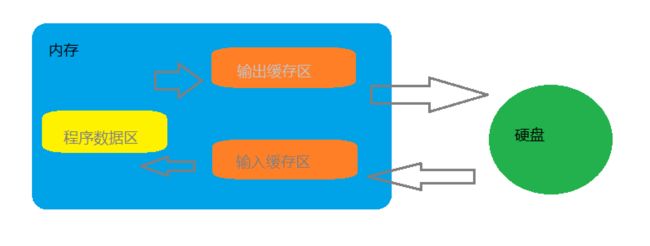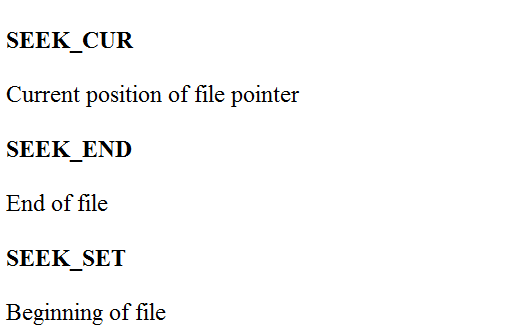C语言—文件操作
1.为什么使用文件
使用文件可以直接将数据存放到电脑硬盘上,做到数据的持久化
2.什么是文件
硬盘上的文件是文件
但在程序中,我们一般谈的文件有两种:程序文件和数据文件(从文件功能角度来分类的)
2.1程序文件
包括源程序文件(后缀为.c),目标文件(windows环境后最为.obj),可执行文件(windows环境后缀为.exe)
2.2数据文件
文件的内容不一定是程序,而是程序运行时读写的数据,比如程序运行需要从中读取数据的文件,或者输出内容的文件
之前我们所处理数据的输入输出都是以终终端为对象的,即从终端的键盘输入数据,运行结果显示到显示器上
其实有时候我们会把信息输出到磁盘上,当需要的时候再把数据从磁盘上把数据读取到内存中使用,这里处理的就是磁盘上的文件
2.3文件名
文件要有唯一的文件标识,以便用户识别和引用
文件名包含3部分:文件路径+文件主干+文件后缀
例如:c:\code\test.txt
为了方便起见,文件标识常被成为文件名
2.4文本文件和二进制文件
根据数据的组织形式,数据文件被成为文本文件或者二进制文件。
数据在内存中以二进制的形式存储,如果不加转换的输出到外存,就是二进制文件。
如果要求在外存上以ASSCII吗的形式存储,则需要在存储前转换。以ASCII字符的形式存储的文件就是文本文件
一个数据在内存中是怎么存储呢?
字符一律ASCII形式存储,数值型数据既可以用ASCII形式存储,也可以使用二进制形式存储。
如果整数10000,如果以ASCII码形式输出到磁盘中,则磁盘中占用5个字节(每个字符一个字节),而二进制形式输出,则在磁盘上只占4个字节
测试代码:
#include
int main()
{
int a = 10000;
FILE* pf = fopen("test.txt","wb");
fwrite(&a,4,1,pf);//二进制的形式写到文件中 写一个四个字节的数据,放到pf维护的文件当中去
pf = NULL;
return 0;
} 3.文件缓冲区
ANSIC 标准采用“缓冲文件系统”处理的数据文件的,所谓缓冲文件系统是指系统自动地在内存中为程序
中每一个正在使用的文件开辟一块“文件缓冲区”。从内存向磁盘输出数据会先送到内存中的缓冲区,装
满缓冲区后才一起送到磁盘上。如果从磁盘向计算机读入数据,则从磁盘文件中读取数据输入到内存缓
冲区(充满缓冲区),然后再从缓冲区逐个地将数据送到程序数据区(程序变量等)。缓冲区的大小根
据C编译系统决定的。
#include
#include
int main()
{
FILE* pf = fopen("test.txt", "w");
fputs("abcdef", pf);//先把代码放到输出缓存区
printf("睡眠10秒-已经写数据了,打开test.txt文件,发现文件没有内容\n");
Sleep(10000);
printf("刷新缓冲区\n");
fflush(pf);刷新缓冲区时,才将输出缓冲区的数据写到文件(磁盘)
//注:fflush 在高版本的VS上不能使用了
printf("再睡眠10秒-此时,再次打开test.txt文件,文件有内容了\n");
Sleep(10000);
fclose(pf);
//注:fclose在关闭文件的时候,也会刷新缓冲区
pf = NULL;
return 0;
} 这里可以得出一个结论:
因为有缓冲区的存在,C语言在操作文件的时候,需要做刷新缓冲区或者在文件操作结束的时候关闭文
件。
如果不做,可能导致读写文件的问题。
4.文件的打开和关闭
4.1文件指针
缓冲文件系统中,关键的概念是“文件类型指针”,简称“文件指针”
每个被使用的文件都在内存中开辟了一个相应的文件信息区,用来存放文件的相关信息(如文件的名
字,文件状态及文件当前的位置等)。这些信息是保存在一个结构体变量中的。该结构体类型是有系统
声明的,取名FILE.
VS2013编译环境提供的 stdio.h 头文件中有以下的文件类型申明:
struct _iobuf
{
char *_ptr;
int _cnt;
char *_base;
int _flag;
int _file;
int _charbuf;
int _bufsiz;
char *_tmpfname;
};
typedef struct _iobuf FILE;不同的C编译器的FILE类型包含的内容不完全相同,但是大同小异。
每当打开一个文件的时候,系统就会根据文件的情况自动创建一个FILE结构的变量,并填充其信息,使用者不用不必关心细节
一般都是通过FILE指针来维护这个FILE结构的变量
我们可以创建一个FILE*的指针变量
FILE*pf;//文件指针变量定义pf是一个指向FILE类型数据的指针变量。可以使pf指向某个文件的文件信息区(是一个结构体变量)。通过该文件信息区就能够访问该文件,也就是说指针变量够找到与它关联的文件
例如:
4.2文件的打开和关闭
文件在读写前之前应该先打开文件,在使用结束后应该关闭文件
//大开文件
FILE*fopen(const char*filename,const char*mode);
//关闭文件
int fcolse(FILE*stream);文件使用方式 |
含义 |
如果指定文件不存在 |
“r”(只读) |
为了输入数据,打开一个已经存在的文本文件 |
出错 |
“w”(只写) |
为了输出数据,打开一个文本文件 |
建立一个新的文件 |
“a”(追加) |
向文本文件尾添加数据 |
建立一个新的文件 |
“rb”(只读) |
为了输入数据,打开一个二进制文件 |
出错 |
“wb”(只写) |
为了输出数据,打开一个二进制文件 |
建立一个新的文件 |
“ab”(追加) |
向一个二进制文件尾添加数据 |
出错 |
“r+”(读写) |
为了读和写,打开一个文本文件 |
出错 |
“w+”(读写) |
为了读和写,建议一个新的文件 |
建立一个新的文件 |
“a+”(读写) |
打开一个文件,在文件尾进行读写 |
建立一个新的文件 |
“rb+”(读写) |
为了读和写打开一个二进制文件 |
出错 |
“wb+”(读写) |
为了读和写,新建一个新的二进制文件 |
建立一个新的文件 |
“ab+”(读写) |
打开一个二进制文件,在文件尾进行读和写 |
建立一个新的文件 |
例
#include
#include
#include
int main()
{
FILE* pf = fopen("test.txt", "w");
if (pf == NULL)
{
printf("%s\n", strerror(errno));
return 0;
}
//打开成功
//读文件
fclose(pf);
pf = NULL;
return 0;
} 5.文件的顺序读写
功能 |
函数名 |
适用于 |
字符输入函数 |
fgetc |
所有输入流 |
字符输出函数 |
fputc |
所有输出流 |
文本行输入函数 |
fgets |
所有输入流 |
文本行输出函数 |
fputs |
所有输出流 |
格式化输入函数 |
fscanf |
所有输入流 |
格式化输出函数 |
fprintf |
所有输出流 |
二进制输入 |
fread |
文件 |
二进制输出 |
fwrite |
文件 |
fputc
例:
#include
#include
#include
int main()
{
FILE* pfWrite = fopen("TEST.txt","w");//TEST为文件输出流
if (pfWrite == NULL)
{
printf("%s\n", strerror(errno));
return 0;
}
//写文件
fputc('b', pfWrite);
fputc('i', pfWrite);
fputc('t', pfWrite);
fclose(pfWrite);
pfWrite = NULL;
return 0;
} fgetc
例:
#include
#include
#include
int main()
{
FILE* pfRead = fopen("TEST.txt", "r");//TEST为文件输入流
if (pfRead == NULL)
{
printf("%s\n", strerror(errno));
return 0;
}
//写文件
printf("%c\n",fgetc(pfRead));
printf("%c\n",fgetc(pfRead));
printf("%c\n",fgetc(pfRead));
fclose(pfRead);
pfRead = NULL;
return 0;
} 键盘和屏幕都是外部设备
键盘-标准输入设备
屏幕-标准输出设备
是一个程序默认打开的两个流设备
程序运行起来就会默认打开三个流
stdin FILE*
stdout FILE*
stderr FILE*
fgetc/fputc的标准输入流/标准输出流
int main()
{
int ch = fgetc(stdin);
fputc(ch, stdout);
return 0;
}输入一个字符
输出一个字符
fputs
例:
#include
int main()
{
FILE* pf = fopen("test.txt", "w");
if (pf == NULL)
{
return 0;
}
fputs("hello\n", pf);
fputs("world\n", pf);
fclose(pf);
pf = NULL;
return 0;
} fgets
例:
#include
int main()
{
char buf[1000] = { 0 };
FILE* pf = fopen("test.txt", "r");
if (pf == NULL)
{
return 0;
}
printf("%s", fgets(buf, 1000, pf));
printf("%s", fgets(buf, 1000, pf));
fclose(pf);
pf = NULL;
return 0;
} fgets/fputs的标准输入流/标准输出流
#include
int main()
{
char buf[1000] = { 0 };
fgets(buf, 1000, stdin);//从标准输入流读取
fputs(buf, stdout);//输出到标准输出流
return 0;
} fprintf
例:
#include
struct S
{
int n;
float score;
char arr[10];
};
int main()
{
struct S s = { 100,3.14f,"bit" };
FILE* pf = fopen("text.txt", "w");
if (pf == NULL)
{
return 0;
}
//格式化的形式写文件
fprintf(pf, "%d %f %s", s.n, s.score, s.arr);
fclose(pf);
pf = NULL;
return 0;
} fscanf
例:
#include
struct S
{
int n;
float score;
char arr[10];
};
int main()
{
struct S s = {0};
FILE* pf = fopen("text.txt", "r");
if (pf == NULL)
{
return 0;
}
//格式化的形式输入数据
fscanf(pf, "%d %f %s", &(s.n), &(s.score), s.arr);
printf("%d %f %s\n", s.n, s.score, s.arr);
fclose(pf);
pf = NULL;
return 0;
} fprint/fscanf的标准输入流/标准输出流
例:
#include
struct S
{
int n;
float score;
char arr[10];
};
int main()
{
struct S s = { 0 };
fscanf(stdin,"%d %f %s", &(s.n), &(s.score), s.arr);
fprintf(stdout,"%d %f %s", s.n, s.score, s.arr);
return 0;
} 对比一组函数:
sscanf/sprintf
scanf/fscanf/sscanf
printf/fprintf/sprintf
scanf/print 是针对标准输入流/标准输出流的格式化输入/输出语句
fscanf/fprintf 是针对所有输入流/所有输出流的格式化输入/输出语句
sscanf/sprintf sscanf是从字符串中读取格式化的数据
sprintf是把格式化的数据输出(存储到)成字符串
struct S
{
int n;
float score;
char arr[10];
};
#include
int main()
{
struct S s = { 100,3.14f,"abcdef" };
struct S tmp = { 0 };
char buf[1000] = { 0 };
//把格式化的数据转化为字符串
sprintf(buf, "%d %f %s", s.n, s.score, s.arr);
printf("%s\n", buf);
//从buf中读取格式化的数据到tmp中
sscanf(buf, "%d %s %s", &(tmp.n), &(tmp.score), tmp.arr);
printf("%d %f %s\n",tmp.n,tmp.score,tmp.arr);
return 0;
} fwrite
例:
#include
struct S
{
char name[20];
int age;
double score;
};
int main()
{
struct S s = { "张三",20,50.2 };
FILE* pf = fopen("test.txt", "wb");
if (pf == NULL)
{
return 0;
}
//二进制形式写文件
fwrite(&s, sizeof(struct S), 1, pf);
fclose(pf);
pf = NULL;
return 0;
} 因为是以二进制写入的,前面的名字以二进制存储和与字符存储是一样的,所以名字不变,后面则是二进制放进去的乱码
fread
例:
#include
struct S
{
char name[20];
int age;
double score;
};
int main()
{
struct S tmp = { 0 };
FILE* pf = fopen("test.txt", "rb");
if (pf == NULL)
{
return 0;
}
//二进制形式读文件
fread(&tmp, sizeof(struct S), 1, pf);
printf("%s %d %lf\n", tmp.name, tmp.age, tmp.score);
fclose(pf);
pf = NULL;
return 0;
} 6.文件的随机读写
6.1fseek
根据文件指针的位置和偏移量来定位文件指针。
int fseek ( FILE * stream, long int offset, int origin );
//pf 偏移量 文件指针的当前位置SEEK_CUR 文件指针的当前位置
SEEK_END 文件的末尾位置
SEEK_SET 文件的起始位置
#include
int main()
{
FILE* pf = fopen("test.txt", "r");
if (pf == NULL)
{
return 0;
}
//1.定位文件指针
fseek(pf, 2, SEEK_CUR);
//2.读取文件
int ch = fgetc(pf);
printf("%c\n", ch);
fclose(pf);
pf = NULL;
return 0;
} 6.2ftell
返回文件指针相对于起始位置的偏移量
long int ftell(FILE*stream);#include
int main()
{
FILE* pf = fopen("test.txt", "r");
if (pf == NULL)
{
return 0;
}
//1.定位文件指针
//fseek(pf, 2, SEEK_CUR);
fgetc(pf);
int pos = ftell(pf);
printf("%d\n", pos);
fclose(pf);
pf = NULL;
return 0;
} 6.3rewind
void rewind(FILE*stream);#include
int main()
{
FILE* pf = fopen("test.txt", "r");
if (pf == NULL)
{
return 0;
}
//1.定位文件指针
//fseek(pf, 2, SEEK_CUR);
int ch=fgetc(pf);
rewind(pf);
printf("%c\n", ch);
fclose(pf);
pf = NULL;
return 0;
} 7.文本读取结束判定
被错误使用的feof
注:
在文件读取过程中,不能用feof函数的返回值直接用来判断文件的是否结束。
而是应用于当文件读取结束的时候,判断是读取失败结束,还是遇到文件尾结束。
fgetc函数返回值的分析:
读取失败返回EOF
遇到文件末尾,返回EOF,同时设置一个状态。遇到文件末尾了,使用feof来检测这个状态
遇到错误,返回EOF,同时设置一个状态,遇到了错误,是同ferror来检测这个状态
1. 文本文件读取是否结束,判断返回值是否为 EOF ( fgetc ),或者 NULL ( fgets )
例如:
fgetc 判断是否为 EOF .
fgets 判断返回值是否为 NULL .
2. 二进制文件的读取结束判断,判断返回值是否小于实际要读的个数。
例如:
fread判断返回值是否小于实际要读的个
正确的使用:
文本文件的例子:
int main()
{
FILE* pf = fopen("test.txt", "r");
if (pf == NULL)
{
perror("open file test2.txt");
return 0;
}
int ch = 0;
while ((ch = fgetc(pf)) != EOF)
{
putchar(ch);
}
if (ferror(pf))
{
printf("error\n");
}
else if (feof)
{
printf("end of file\n");
}
fclose(pf);
pf = NULL;
return 0;
}二进制文件的例子:
#include
enum { SIZE = 5 };
int main(void)
{
double a[SIZE] = {1.,2.,3.,4.,5.};
FILE *fp = fopen("test.bin", "wb"); // 必须用二进制模式
fwrite(a, sizeof *a, SIZE, fp); // 写 double 的数组
fclose(fp);
double b[SIZE];
fp = fopen("test.bin","rb");
size_t ret_code = fread(b, sizeof *b, SIZE, fp); // 读 double 的数组
if(ret_code == SIZE)
{
puts("Array read successfully, contents: ");
for(int n = 0; n < SIZE; ++n) printf("%f ", b[n]);
putchar('\n');
}
else
{ // error handling
if (feof(fp))
printf("Error reading test.bin: unexpected end of file\n");
else if (ferror(fp))
{
perror("Error reading test.bin");
}
}
fclose(fp);
} 以上就是本篇文章的内容了,很感谢你能看到这里
如果觉得内容对你有帮助的话,不妨点个关注
我会继续更新更高质量的内容,我们一同学习,一同进步!

























